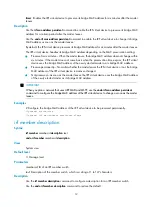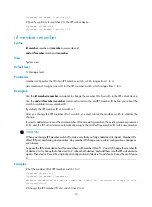
13
By default, no description is configured for any IRF member switch.
Examples
# Configure a description for IRF member switch 1.
<Sysname> system-view
[Sysname] irf member 1 description F1Num001
irf member priority
Syntax
irf member
member-id
priority
priority
undo irf member
member-id
priority
View
System view
Default level
3: Manage level
Parameters
member-id
: ID of an IRF member switch.
priority
: Priority value, ranging from 1 to 32.
Description
Use the
irf member priority
command to specify a priority for an IRF member switch.
Use the
undo irf member priority
command to restore the default.
By default, the priority of a member switch is 1.
The greater the priority value, the higher the priority. A member with a higher priority is more likely to be
the master, and more likely to preserve its ID in a member ID collision.
Examples
# Specify a priority for the local switch.
<Sysname> display irf
Switch Role Priority CPU-Mac
*1 Slave 29 00e0-fc00-1115
2 Slave 1 00e0-fc00-1615
+3 Master 32 00e0-fc00-1015
4 Slave 30 00e0-fc00-1515
--------------------------------------------------------
* indicates the device is the master.
+ indicates the device through which the user logs in.
The Bridge MAC of the IRF is: 00e0-fc00-1000
Auto upgrade : yes
Mac persistent : always
Domain ID : 0
The output shows that the member ID of the local switch is 3, and you can specify a priority for the local
switch by providing its member ID.
<Sysname> system-view













































